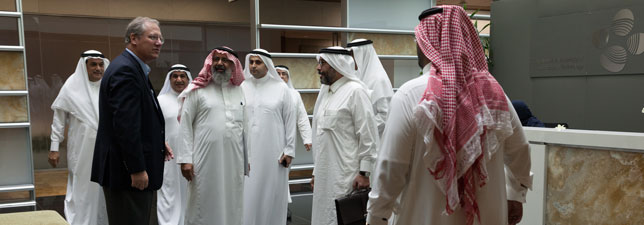Business Development

Vision
Business Development aims to be the region's premier platform for Business Development Engagement.
Mission
Business Development advances and promotes all new and existing business opportunities (major commercial projects) within the University's facilities, community, and properties to generate a long-term, continuous revenue stream.
Who We Are
Business Development, in partnership with KAUST's various divisions and the Saudi Arabian and global investment community, identify and develop new, profitable, and sustainable business opportunities and services that leverage the University's facilities, properties, and community.
Business Development pursues business opportunities (major commercial projects) that support KAUST's operating and capital requirements and/or reduces the University's dependence on its endowment.
Any major commercial project should generate a minimum of at least $10 million dollars per annum of revenue to KAUST, and it may be within or outside the core business of the University.
What We Do
Project Lifecycle
The Business Development project lifecycle consists of four principal phases: Initiation, Planning, Execution, and Closure. Business Development's involvement in the project occurs primarily in the initiation phase. As KAUST's Proponent/ Business Sponsor, we work closely with an investor(s) to plan, execute, and bring the project to a successful closure.
Our Process
Stages of Initiation
1) Initiation / Initial Concept In the Initial Concept stage, a business opportunity to be pursued is recognized or a business problem to be resolved is identified.
Business Opportunity Requirements:
- A summary of the generic opportunity.
- Any supporting evidence to prove that the opportunity is real for KAUST as a revenue generator.
- The positive impact which the opportunity will have on KAUST.
- A timeframe within which the opportunity will likely exist.
Business Problem Requirements:
- A generic description of the core issue at hand.
- The reasons why the problem exists.
- The elements which create the problem (e.g., human, process, technology).
- The impact of the problem on KAUST or the Business (e.g., financial, cultural, operational)
- The timeframes within which it must be resolved.
2) Business Case
During this stage, the opportunity or problem is more specifically defined and analyzed and potential solutions are assessed. Once a business opportunity has been identified, a Business Case is prepared outlining the justification for initiating the project. It includes:
- A detailed definition of the problem or opportunity.
- An analysis of the potential solutions available. For each solution, the potential benefits, costs, risks and issues are documented.
- A formal feasibility study may be commissioned if the feasibility of any particular solution is not clear.
- The recommended solution and a generic implementation plan.
3) Feasibility Study
After the Business Case stage, a formal Feasibility Study may be required. Feasibility Study simply adds rigor to the Business Case.
- The purpose of the Feasibility Study is to assess the likelihood of a particular solution achieving the benefits outlined in the Business Case.
- The Feasibility Study will also evaluate whether the forecast costs are reasonable, the solution is achievable, the risks are acceptable, and/or any likely issues are avoidable.
4) Approaching Investors
Working closely with KAUST's Legal Counsel and Finance Department and outside specialists, Business Development approaches investors and develops the financial and legal framework as well as the structure for the feasible solution. Our seven primary steps to solicit investors include:
- Business Development sends a Solicitation of Interest (SOI) to potential investors to request "Business Information".
- The SOI is followed by a Non-Disclosure Agreement (NDA) with responders.
- Business Development sends a Business Brief of the project/opportunity and invites responders.
- Meetings will be scheduled and conducted with prospective Investors.
- A "Heads of Agreement" will be developed to establish principles of a potential relationship between investor(s) and KAUST.
- Business Development will review and select the best candidate.
- Enter into a Contractual (or joint venture) agreement, submitted to the KAUST Board of Trustees.
5) Project Charter
A Project Charter is prepared from the information obtained in the previous stages; it defines the vision, objectives, scope, and deliverables for the project's final review and approval (prior to implementation). The Project Charter will be developed by the Proponent/Business Sponsor and Investor with input from Business Development. Once the recommended solution is approved and an investor has been secured, a Project Charter (if required) is completed:
- The Project Charter also provides the joint venture structure and a summarized plan of the activities, resources, and funding required to undertake the project.
Chuck Reynolds
Contributor


